The iPhone 5s Review
by Anand Lal Shimpi on September 17, 2013 9:01 PM EST- Posted in
- Smartphones
- Apple
- Mobile
- iPhone
- iPhone 5S
Display
The iPhone 5s, like the iPhone 5c, retains the same 4-inch Retina Display that was first introduced with the iPhone 5. The 4-inch 16:9 LCD display features a 1136 x 640 resolution, putting it at the low end for most flagship smartphones these days. It was clear from the get-go that a larger display wouldn’t be in the cards for the iPhone 5s. Apple has stuck to its two generation design cadence since the iPhone 3G/3GS days and it had no indication of breaking that trend now, especially with concerns of the mobile upgrade cycle slowing. Recouping investment costs on platform and industrial design are a very important part of making the business work.

Apple is quick to point out that iOS 7 does attempt to make better use of display real estate, but I can’t shake the feeling of being too cramped on the 5s. I’m not advocating that Apple go the route of some of the insanely large displays, but after using the Moto X for the past month I believe there’s a good optimization point somewhere around 4.6 - 4.7”. I firmly believe that Apple will embrace a larger display and branch the iPhone once more, but that time is just not now.
The 5s’ display remains excellent and well calibrated from the factory. In an unusual turn of events, my iPhone 5c sample came with an even better calibrated display than my 5s sample. It's a tradeoff - the 5c panel I had could go way brighter than the 5s panel, but its black levels were also higher. The contrast ratio ended up being very similar between the devices as a result. I've covered the panel lottery in relation to the MacBook Air, but it's good to remember that the same sort of multi-source components exist in mobile as well.
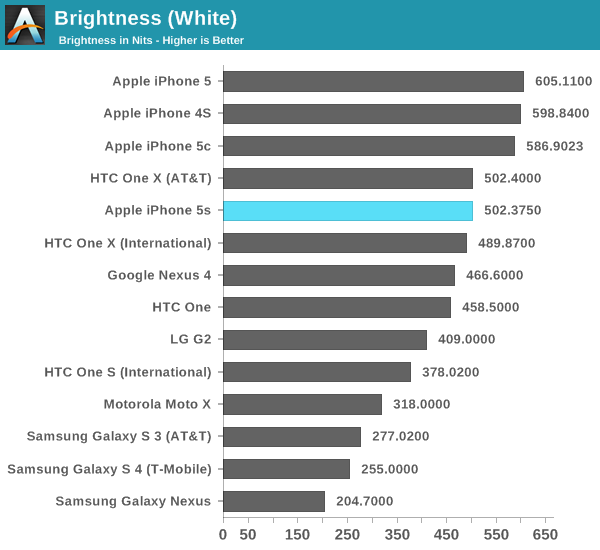
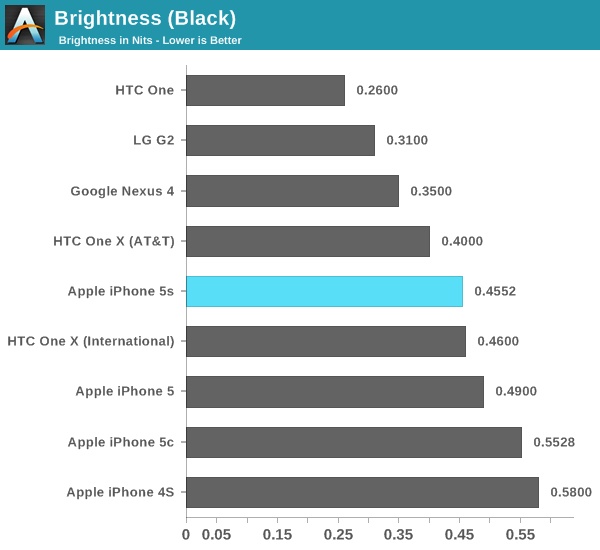
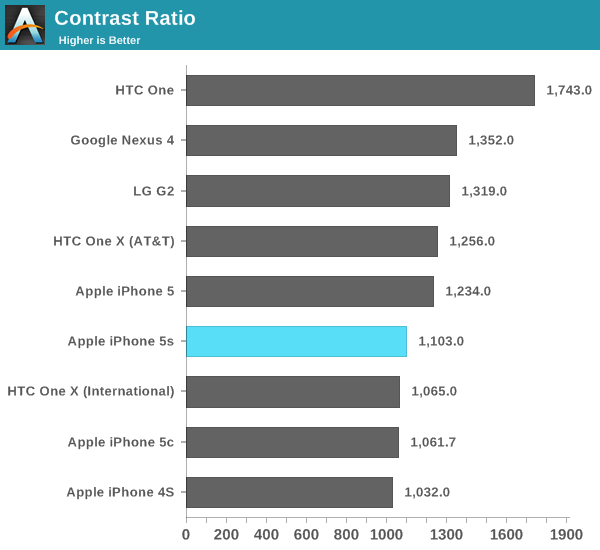
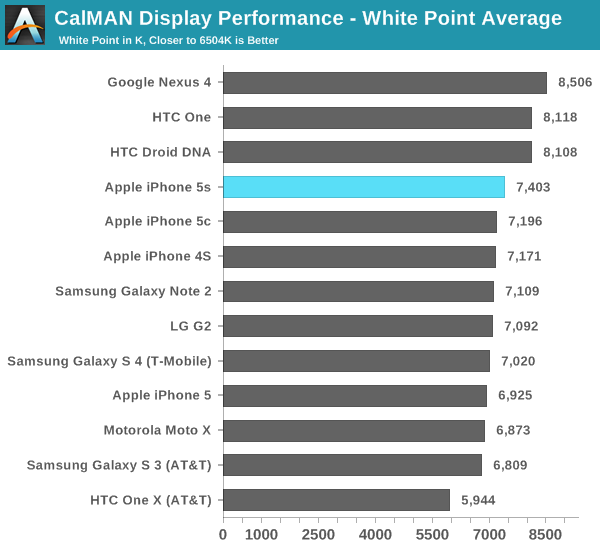

Color accuracy is still excellent just out of the box. Only my iPhone 5c sample did better than the 5s in our color accuracy tests. Grayscale accuracy wasn't as good on my 5s sample however.
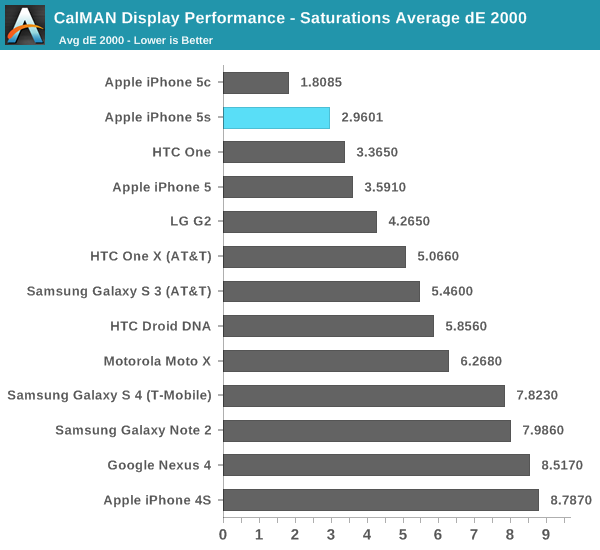
Saturations:

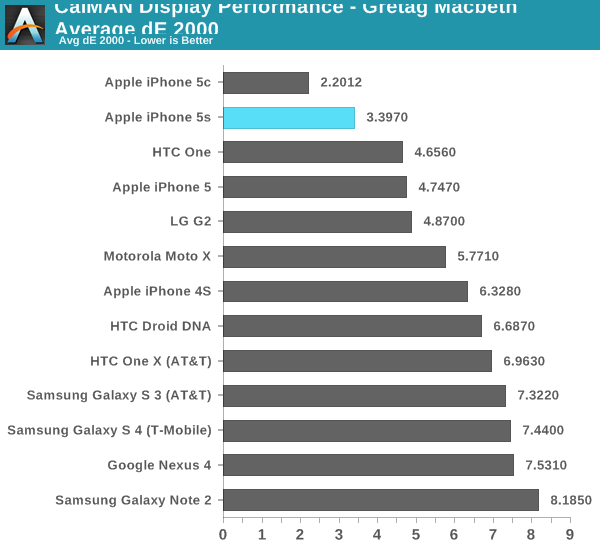
GMB Color Checker:

Cellular
When early PCB shots of the 5s leaked, I remember Brian counting solder pads on the board to figure out if Apple moved to a new Qualcomm baseband solution. Unfortunately his count came out as being the same as the existing MDM9x15 based designs, which ended up what launched. It’s unclear whether or not MDM9x25 was ready in time in order to be integrated into the iPhone 5s design, or if there was some other reason that Apple chose against implementing it here. Regardless of the why, the result is effectively the same cellular capabilities as the iPhone 5.
Apple tells us that the wireless stack in the 5c and 5s is all new, but the lack of LTE-Advanced features like carrier aggregation and Category 4 150Mbps downlink make it likely that we’re looking at a MDM9x15 derivative at best. LTE-A support isn’t an issue at launch, however as Brian mentioned on our mobile show it’s going to quickly become a much needed feature for making efficient use of spectrum and delivering data in the most power efficient way.
The first part is relatively easy to understand. Carrier aggregation gives mobile network operators the ability of combining spectrum across non-contiguous frequency bands to service an area. The resulting increase in spectrum can be used to improve performance and/or support more customers on LTE in areas with limited present day LTE spectrum.
The second part, improving power efficiency, has to do with the same principles of race to sleep that we’ve talked about for years. The faster your network connection, the quicker your modem can transact data and fall back into a lower power sleep state.
The 5s’ omission of LTE-A likely doesn’t have immediate implications, but those who hold onto their devices for a long time will have to deal with the fact that they’re buying at the tail end of a transition to a new group of technologies.
In practice I didn’t notice substantial speed differences between the iPhone 5s, 5c and the original iPhone 5. My testing period was a bit too brief to adequately characterize the device but I didn’t have any complaints. The 5s retains the same antenna configuration as the iPhone 5, complete with receive diversity. As Brian discovered after the launch, the Verizon iPhone 5s doesn’t introduce another transmit chain - so simultaneous voice and LTE still aren’t possible on that device.
Apple is proud of its support for up to 13 LTE bands on some SKUs. Despite the increase in support for LTE bands there are a lot of iPhone 5s SKUs that will be shipped worldwide:
| Apple iPhone 5S and 5C Banding | |||||||
| iPhone Model | GSM / EDGE Bands | WCDMA Bands | FDD-LTE Bands | TDD-LTE Bands | CDMA 1x / EVDO Rev A/B Bands | ||
|
5S- A1533 (GSM) |
850, 900, 1800, 1900 MHz | 850, 900, 1700/2100, 1900, 2100 MHz | 1, 2, 3, 4, 5, 8, 13, 17, 19, 20, 25 | N/A | N/A | ||
|
5S- A1533 (CDMA) |
800, 1700/2100, 1900, 2100 MHz | ||||||
|
5S- A1453 |
1, 2, 3, 4, 5, 8, 13, 17, 18, 19, 20, 25, 26 | ||||||
|
5S- A1457 5C- A1507 |
850, 900, 1900, 2100 MHz | 1, 2, 3, 5, 7, 8, 20 | N/A | ||||
|
5S- A1530 5C- A1529 |
1, 2, 3, 5, 7, 8, 20 | 38, 39, 40 | |||||
| Apple iPhone 5S/5C FCC IDs and Models | |||
| FCC ID | Model | ||
| BCG-E2642A | A1453 (5S) A1533 (5S) | ||
| BCG-E2644A | A1456 (5C) A1532 (5C) | ||
| BCG-E2643A | A1530 (5S) | ||
| BCG-E2643B | A1457 (5S) | ||
| BCG-E2694A | A1529 (5C) | ||
| BCG-E2694B | A1507 (5C) | ||
WiFi
WiFi connectivity also remains unchanged on the iPhone 5s. Dual band (2.4/5GHz) 802.11n (up to 150Mbps) is the best you’ll get out of the 5s. We expected Apple to move to 802.11ac like some of the other flagship devices we’ve seen in the Android camp, but it looks like you’ll have to wait another year for that.
I don’t believe you’re missing out on a lack of 802.11ac support today, but over the life of the iPhone 5s I do expect greater deployment of 802.11ac networks (which can bring either performance or power benefits to a mobile platform).
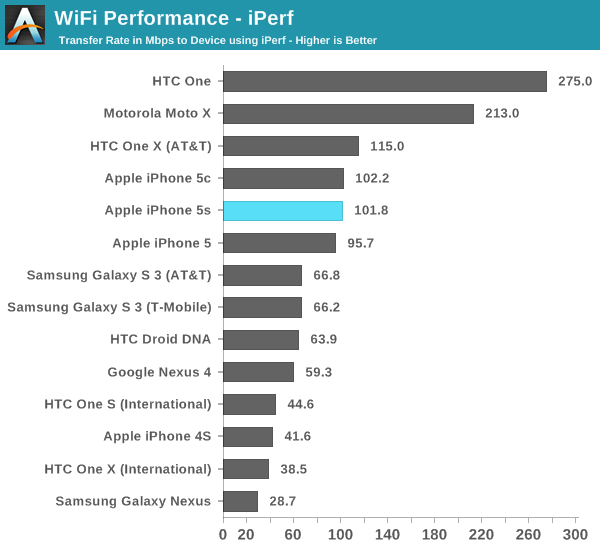
WiFi performance seems pretty comparable to the iPhone 5. The HTC One and Moto X pull ahead here as they both have 802.11ac support.













464 Comments
View All Comments
Wilco1 - Thursday, September 19, 2013 - link
The Geekbench results are indeed skewed by AES encryption. The author claimed AES was the only benchmark where they use hardware acceleration when available. There has been a debate on fixing the weighting or to place hardware accelerated benchmarks in a separate category to avoid skewing the results. So I'm hoping a future version will fix this.As for cross-platform benchmarking, Geekbench currently uses the default platform compiler (LLVM on iOS, GCC on Android, VC++ on Windows). So there will be compiler differences that skew results slightly. However this is also what you'd get if you built the same application for iOS and Android.
smartypnt4 - Thursday, September 19, 2013 - link
A lot of the other stuff in Geekbench seems to be fairly representative, though. Except a few of the FP ones like the blur and sharpen tests...It surely can't be hard to have Geekbench omit those results. I think if they did that, you'd see that the A7 is roughly 50-60% faster than the A6 instead of 100% faster, but I'm not sure there. I'd have to go and do work to figure that out. Which is annoying :-)
name99 - Wednesday, September 18, 2013 - link
I'd agree with the tweaks you suggest: (improved memory controller and prefetcher, doubling of L2, larger branch predictor tables).There is also scope for a wider CPU. Obviously the most simple-minded widening of a CPU substantially increases power, but there are ways to limit the extra power without compromising performance too much, if you are willing to spend the transistors. I think Apple is not just willing to spend the transistors, but will have them available to spend once they ditch 32-bit compatibility. At that point they can add a fourth decoder, use POWER style blocking of instructions to reduce retirement costs, and add whatever extra pipes make sense.
The most useful improvement (in my experience) would be to up the L1 from being able to handle one load+store cycle to two loads+ one store per cycle, but I don't know what the power cost of that is --- may be too high.
On the topic of minor tweaks, do we know what the page size used by iOS is? If they go from 4K to 16K and/or add support for large pages, they could get a 10% of so speed boost just from better TLB coverage.
(And what's Android's story on this front? Do they stick with standard 4K pages, or do they utilize 16 or 64K pages and/or large pages?)
extide - Wednesday, September 18, 2013 - link
Those are some pretty generous numbers you pulled out of your hat there. It's not as easy as just do this and that and bam, you have something to compete with Intel Core series stuff. No. I mean yeah, Apple has done a great job here and I wish someone else was making CPU's like this for the Android phones but oh well.name99 - Wednesday, September 18, 2013 - link
"Now, I will agree that this does prove that if Apple really wanted to, they could build something to compete with Haswell in terms of raw throughput."I agree with your point, but I think we should consider what an astonishing statement this is.
Two years ago Apple wasn't selling it's own CPU. They burst onto the scene and with their SECOND device they're at an IPC and a performance/watt that equals Intel! Equals THE competitor in this space, the guys who are using the best process on earth.
If you don't consider that astonishing, you don't understand what has happened here.
(And once again I'd make my pitch that THIS shows what Intel's fatal flaw is. The problem with x86 is not that it adds area to a design, or that it slows it down --- though it does both. The problem is that it makes design so damn complex that you're constantly lagging; and you're terrified of making large changes because you might screw up.
Apple, saddled with only the much smaller ARM overhead, has been vastly more nimble than Intel.
And it's only going to get worse if, as I expect, Apple ditches 32-bit ARM as soon as they can, in two years or so, giving them an even easier design target...)
What's next for Apple?
At the circuit level, I expect them to work hard to make their CPU as good at turboing as Intel. (Anand talked about this.)
At the ISA level, I expect their next major target to be some form of hardware transactional memory --- it just makes life so much easier, and, even though they're at two cores today, they know as well as anyone that the future is more cores. You don't have to do TM the way Intel has done it; the solution IBM used for POWER8 is probably a better fit for ARM. And of course if Apple do this (using their own extensions, because as far as I know ARM doesn't yet even have a TM spec) it's just one more way in which they differentiate their world from the commodity ARM world.
smartypnt4 - Wednesday, September 18, 2013 - link
@extide: agreed.@name99: It is very astonishing indeed. Then again, a high profile company like Apple has no problem attracting some of the best talent via compensation and prestige.
They've still got quite a long way to match Haswell, in any case. But the throughput is technically there to rival Intel if they wanted to. I would hope that Haswell contains a much more advanced branch predictor and prefetcher than what Apple has, but you never know. My computer architecture professor always said that everything in computer architecture has already been discovered. The question now is when will it be advantageous to spend the transistors to implement the most complicated designs.
The next year is going to be very interesting, indeed.
Bob Todd - Wednesday, September 18, 2013 - link
How many crows did you stuff down after claiming BT would be slower than A15 and even A12? Remember posting this about integer performance?"Silverthorne < A7 < A9 < A9R4 < Silvermont < A12 < Bobcat < A15 < Jaguar"
Apple's A7 looks great, but you've made so many utterly ridiculous Intel performance bashing posts that it's pretty much impossible to take anything you say seriously.
Wilco1 - Wednesday, September 18, 2013 - link
BT has indeed far lower IPC than A15 just like I posted - pretty much all benchmark results confirm that. On Geekbench 3 A15 is 23-25% faster clock for clock on integer and FP.The jury is still out on A12 vs BT as we've seen no performance results for A12 so far. So claiming I was wrong is not only premature but also incorrect as the fact is that Bay Trail is slower.
Wilco1 - Wednesday, September 18, 2013 - link
Also new version with A7 and A57 now looks like this:Silverthorne < A7 < A9 < A9R4 < Silvermont < A12 < Bobcat < A15 < Jaguar < A57 < Apple A7
Bob Todd - Wednesday, September 18, 2013 - link
Cherry picking a single benchmark which is notoriously inaccurate at comparisons across platforms/architectures doesn't make you "right", it just makes you look like more of a troll. Bay Trail has better integer performance than Jaguar (at near identical base clocks), so by your own ranking above it *has* to be faster than A12 and A15.You show up in every ARM article spouting the same drivel over and over again, yet you were mysteriously absent in the Bay Trail performance preview. Here's the link if you want to try to find a way to spin more FUD.
http://anandtech.com/show/7314/intel-baytrail-prev...
Apple's A7 looks great, and IT is still the powerhouse of mobile graphics. The A7 version in the iPad should be a beast. None of that makes most of your comments any less loony.